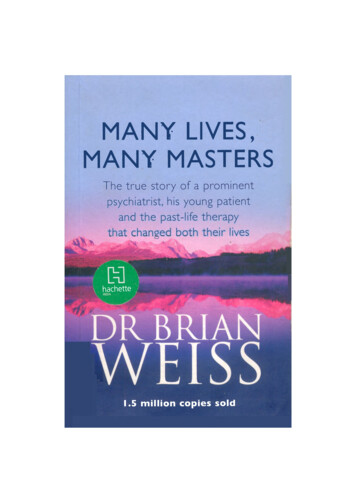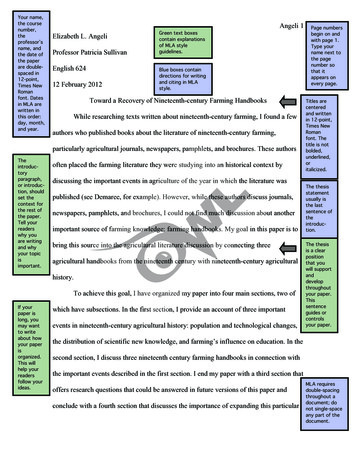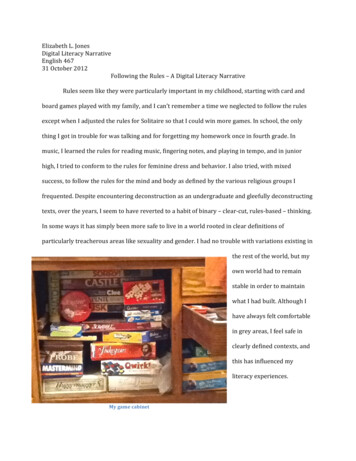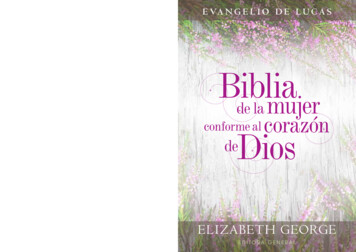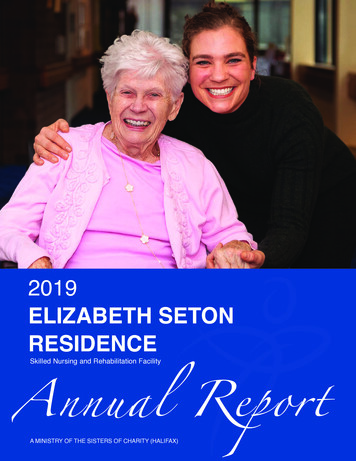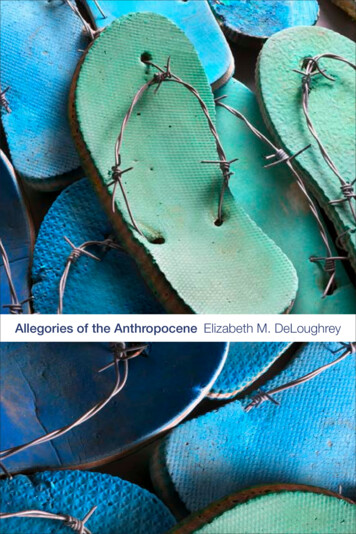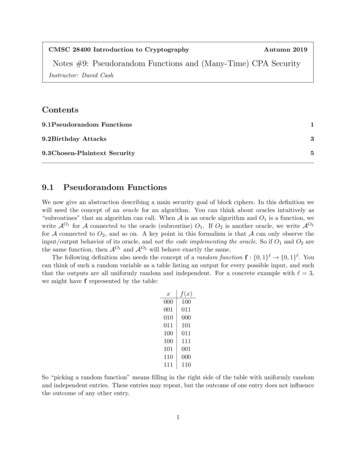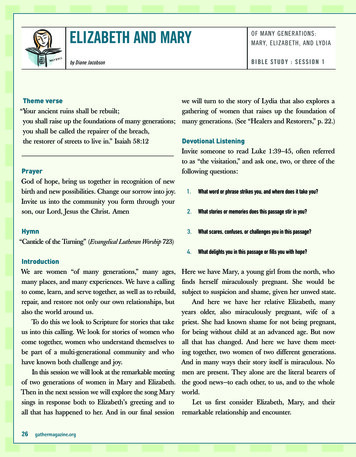
Transcription
ELIZABETH AND MARYOF MANY GENERATIONS:MARY, ELIZABETH, AND LYDIAby Diane JacobsonBIBLE STUDY : SESSION 1Theme verse“Your ancient ruins shall be rebuilt;you shall raise up the foundations of many generations;you shall be called the repairer of the breach,the restorer of streets to live in.” Isaiah 58:12PrayerGod of hope, bring us together in recognition of newbirth and new possibilities. Change our sorrow into joy.Invite us into the community you form through yourson, our Lord, Jesus the Christ. AmenHymn“Canticle of the Turning” (Evangelical Lutheran Worship 723)IntroductionWe are women “of many generations,” many ages,many places, and many experiences. We have a callingto come, learn, and serve together, as well as to rebuild,repair, and restore not only our own relationships, butalso the world around us.To do this we look to Scripture for stories that takeus into this calling. We look for stories of women whocome together, women who understand themselves tobe part of a multi-generational community and whohave known both challenge and joy.In this session we will look at the remarkable meetingof two generations of women in Mary and Elizabeth.Then in the next session we will explore the song Marysings in response both to Elizabeth’s greeting and toall that has happened to her. And in our final session26gathermagazine.orgwe will turn to the story of Lydia that also explores agathering of women that raises up the foundation ofmany generations. (See “Healers and Restorers,” p. 22.)Devotional ListeningInvite someone to read Luke 1:39–45, often referredto as “the visitation,” and ask one, two, or three of thefollowing questions:1.What word or phrase strikes you, and where does it take you?2.What stories or memories does this passage stir in you?3.What scares, confuses, or challenges you in this passage?4.What delights you in this passage or fills you with hope?Here we have Mary, a young girl from the north, whofinds herself miraculously pregnant. She would besubject to suspicion and shame, given her unwed state.And here we have her relative Elizabeth, manyyears older, also miraculously pregnant, wife of apriest. She had known shame for not being pregnant,for being without child at an advanced age. But nowall that has changed. And here we have them meeting together, two women of two different generations.And in many ways their story itself is miraculous. Nomen are present. They alone are the literal bearers ofthe good news —to each other, to us, and to the wholeworld.Let us first consider Elizabeth, Mary, and theirremarkable relationship and encounter.
Elizabeth: The Older Generation5.What gifts do you imagine that older generations bringto the table? Make a list.6.Gathering up the responses from the devotional listening, ask onemore question: What observations did the group make about Elizabeth?Did you notice in verse 41 that Elizabeth is “filled withthe Holy Spirit?” How do we hear this? What is it tobe Spirit-filled? How would the readers of Luke haveheard this?Luke uses this phrase regularly throughout Acts(Acts 2:4; 4:8, 31; 7:55; 9:17; 13:9, 52). For Luke thefilling of the spirit is an outpouring of the spirit ofprophecy (see Micah 3:8 and Ezekiel 43:5). A personfilled with the spirit speaks to others of the coming ofthe Messiah into the world and also acts in the light ofthis new reality. Luke only uses this designation in thefirst two chapters. He uses it to introduce us to thosewho first hear of the coming of Jesus as messiah (Luke1:15, 41, 67, 80; 2:25–27).So here is Elizabeth. She hears Mary’s greeting andher child ( John the Baptist) leaps in her womb. Even asan unborn child, John has a word of prophecy for hismother and prepares the way. And in turn, his mother,Elizabeth, is “filled with the Holy Spirit” and speaks herown word of prophecy.Did you notice that Elizabeth’s house is named as“the house of Zechariah?” Did you wonder who he is?To answer this question you need to put our story ofthe visitation in its literary context.Exploring the Literary ContextREAD LUKE 1:5–25.In these verses you discover that Zechariah is a priestand that he and Elizabeth are from priestly lines andthat both are “righteous,” according to the law (1:5–6).The priests and their families were set apart and hada place of privilege. We learn this by reading the Bookof Leviticus and by studying the role of priesthoodin the days of Jesus in any number of sources fromthat time. Given his status, Zechariah is the expectedhero of this story. And sure enough, he receives anangelic visitation in the very manner of Abraham (seeGenesis 18:1–15). Think about the similarity betweenthese two stories. Like Abraham’s wife, Sarah, so alsoZechariah’s wife, Elizabeth, is barren. Like Abraham,Zechariah has trouble believing that an elderly couplecan have a child. But this time, the angel questionsZechariah’s doubt and issues a judgment of silence.Think about this judgment and its effects. Howdo you feel when someone tells you that you cannotspeak? What if that someone was an angelic visitor?How could you carry on in your role in life? Zechariahis temporarily unable to communicate to his people.But more significantly, he cannot do his job of praisingGod and leading his community to do the same.Not so Elizabeth. She in fact takes over the job ofpraise in verse 25. She accepts her miraculous statewithout question and says: “This is what the Lord hasdone for me when he looked favorably on me and tookaway the disgrace I have endured among my people.”Elizabeth understands that her place in the community is changed and that her disgrace in not havinga child is taken away. And most importantly, she proclaims this to be the Lord’s doing. She has taken overthe work of praise. Actually as the one who sings praises, she is not only taking on the work of her husband,she is taking on the work of countless generations ofwomen before her: Miriam and Deborah, Hannah andJudith. These women and more are singers of songs.This is a theme to which we will return.What have we learned then about Elizabeth? She is filled with the Holy Spirit. She is from a priestly family, is marriedto a priest, and is righteous. She takes on the role as both a substitutepriest and woman of declaring God’s praise.June 201427
Words of BlessingsWith this in mind, let us return to our home passageand look once more at Elizabeth’s response to Mary’sgreeting and to her own child’s leaping.With no hesitation at all, Elizabeth speaks a tripleword of blessing. Elizabeth first blesses Mary—“Blessedare you among women” (Luke 1:42a).What reasons do you think she has for such a blessing? Is she blessing Mary for coming for a visit? Suchthoughts seem possible given verse 43.There is a biblical tradition of blessing people. Twoearlier such blessings are relevant here. Deborah inher song, proclaims “Most blessed of women be Jael”( Judges 5:24) because Jael has defeated the powerfulleader of the enemy forces. And in (the Apocryphabook) Judith 13:18, Judith is similarly praised. Bothwomen are declared blessed because, as biblical scholarRaymond Brown puts it in The Birth of the Messiah, “thephysically weak (are) used to confound the strong.”When Elizabeth declares Mary blessed, Mary joinsthe ranks of her foremothers. The one who seemsweak is most strong. Elizabeth sees this and invites usto see it as well.Elizabeth next blesses the child in Mary’s womb,Jesus—“and blessed is the fruit of your womb (1:42b).”In doing this, Elizabeth becomes the very first personin Luke’s gospel to bless and praise the coming messiah. Hidden in the midst of this complex chapter, onecan easily miss this momentous recognition and blessing.And then there is Elizabeth’s final blessing, “Andblessed is she who believed that there would be a fulfillment of what was spoken to her by the Lord” (1:45).Elizabeth returns once more to bless Mary. Theblessing of the mother surrounds the blessing of thechild. This final blessing is startling on at least twocounts. First, Elizabeth knows that Mary had beenspoken to and that she had believed. This adds to thepicture that Elizabeth, filled with the Spirit, is a prophet.28gathermagazine.orgSecond, the Greek word used for this third blessing isdifferent from the first two. This blessing is makaria(μακαρία) the very same word used in Jesus’ beatitudes.When we know this, something remarkable happens to our hearing. Not only is Mary declared blessedfor believing the truth of what she is told by God, soare all who also believe. Elizabeth is blessing Maryto be certain, but she is also blessing herself and us.Blessed is anyone, us included, who believes in thefuture fulfillment of the promises of God. (See “Abundant Blessing,” p. 14.)7.Now look back at the list you first made about gifts womenof an older generation bring. How does this compare to the listof gifts that Elizabeth brings?Mary: The Younger GenerationMake a list of the gifts that women of the youngergeneration bring.8.Take some time to consider your usual picture of Mary.Where does your picture of Mary come from, and whatin your eyes, are her most important characteristics?Most folks know something of Mary from Christmaspageants and carols. We often picture Mary sitting bya manger with shepherds and wise men and cows andsheep around and the infant Jesus sitting on her lap.We know the songs.“Once in royal David’s city stood a lowly cattle shed,Where a mother laid her baby in a manger for his bed.Mary was that mother mild, Jesus Christ, her littlechild.” (ELW 269)Here is a time-honored picture of Mary as virgin,mother mild. Compare this picture to the portraitpainted in Luke.Begin with our visitation passage. We know themost about Mary by what Elizabeth tells us in herblessing. That in itself is significant. We often know a
great deal about people by what others say about them.9. Does this picture of Mary match your expected picture of Mary?What do you notice about Mary? We are told sheHow do the gifts Mary brings compare with your list of the giftsgoes out in haste. Sounds like the younger generationthat women of the younger generation bring?to me! And she brings greetings. Then she remainsquiet, almost humble, by implication, before her elder. Elizabeth and Mary:In our passage we are not told much more.Intergenerational RelationshipWe have looked at Elizabeth and Mary separately, butExploring the Literary Contextperhaps the most significant aspect of the visitation isOnce again, we need to look at the verses that come the effect of their coming together.before.Look at their relationship. What do you notice?We find there a double annunciation, that is, a double birth announcement. Following the birth announcement of John to Zechariah, the angel Gabriel makesa parallel announcement to Mary about Jesus (Luke1:26–38). Gabriel begins,“Greetings (literally, rejoice) favored one! The Lordis with you.”Gabriel’s greeting to Mary parallels Mary’s toElizabeth. We learn that Mary is a virgin, engaged toa man called Joseph. We learn that while Elizabethcomes from a priestly line, Mary comes from the houseof David. And just as Elizabeth takes on a priestly role,Mary takes on a royal role. She, a mother, rather thana father, receives the angelic announcement. She is toldher son will be a king, given the throne of David. Sheis given the task of naming the child Jesus. More thanthis, she will be overpowered, the birth miraculous,and the child not only holy but the Son of God.We learn that she is perplexed, that she ponders.We learn that she is given notice not only of her ownpregnancy and birth but also that of Elizabeth.And we learn of her response:“Here am I, the servant of the Lord; let it be withme according to your word.” Her acceptance matchesthe response of many a prophet, from Moses to Isaiahand Jeremiah and more.And then hearing of the pregnancy of her olderrelative, unbidden she goes with haste to be at her side.Seekrenewal of your mindand heart through.June 201429
10. Step back a moment and think about one or two cross-generationalrelationships that have been important to you. What is significantabout those relationships? As a group make a list of the marksof those intergenerational relationships.11. Turn your attention once more to our story of the visitation in Luke.What are the important marks of their relationship?At first glance their encounter is not remarkable at all.A younger woman visits her older kin to exchange stories about their pregnant condition. But the visit entailsa journey on the part of the younger woman. Sheshows a commitment to the relationship. (See “Forgingthe Path,” p. 10.)Exploring the Literary ContextIn the context of the biblical story, we are most shockedthat we sense no rivalry between these two women.Think of Sarah and Hagar (Genesis 16 and 21) or ofRachel and Leah (Genesis 29–30). Of particular importance to this scene is the story of Hannah and her rivalwife, Peninnah (1 Samuel 1).These stories lead us to expect jealousy amongmothers about their pregnancy and their children. Buthere in Luke we find the opposite. We find mutual support, greeting and blessing. In their lack of rivalry thesetwo women model community for us.Take some extra time to look at the full story ofHannah in 1 Samuel 1 and consider the many connections with the first chapter of Luke. We have three women who miraculously conceive. We have two priests who do not understand:Eli and Zechariah. We have two children, Samuel and John, whoare dedicated to be Nazirites and will neverdrink wine nor strong drink. This is to be theirvocation. But mostly we have these three women whostand at the beginning of two crucial junctures30gathermagazine.orgin divine history. Hannah stands at the beginning of the unfolding of the promised line. Herstory introduces us to the sacred story of KingDavid and his heirs and to the prophets, beginning with Samuel who prepares the way forDavid. Meanwhile Mary and Elizabeth stand atthat other starting point, the birth of Jesus—kingand more—preceded by his herald John whoalso prepares the way for the messiah king.Our wonderful multi-generation of woman suddenlyexpands. These two women, Elizabeth and Mary, intheir encounter with each other reach back into theirhistory and join with their ancient foremother, Hannah.12. What women from history, biblical or other, are importantfor your understanding of significant relationships?13. Return once more to the story of the visitation and the marksof the intergenerational relationship.14. We have noted that it is marked by both greeting and blessing.Are there special ways we greet one another? In what ways dowe bless one another?In the story of the visitation, emphasis is put on theolder generation blessing the younger. Such blessingemphasizes the push of blessing into the future. We sawthis earlier with reference to blessing those who believeGod’s word will be fulfilled. So at the same time thatthe encounter reaches deep into the past, it also pressesus ever more into a future filled with hope and promise.Wrapping UpThis brings me to my last point about this encounterbetween the generations. Even though the encounter isbetween two individual women, it is not at all a privateaffair. Their encounter is very much about the future ofthe whole world. These two women, marked by physi-
cal embrace, loud exclamation, and prenatal leaping,call us to an incarnate future of God. These childrenthey carry are the ones who will carry us forward. Thisis how God works, through incarnation, through realpeople and their real relationships. This is how Christis born. This is how hope is born.Looking Back16. Which aspect of this cross-cultural encounter between Maryand Elizabeth intersect with your lists of the marks of theintergenerational relationships in your past?17. What would you like to pass on to future generations?You might end your session by blessing one another,remembering a particular insight each of you shared.15. Does this encounter between Mary and Elizabeth give birthLooking ForwardWe are only halfway through the intergenerationalAlyce McKenzie, in a wonderful blog called “Edgy encounter between Mary and Elizabeth. We haveExegesis” (http://tinyurl.com/n5z94vz) says about this explored Elizabeth’s reactions, but we have yet tomeeting between Mary and Elizabeth that it is “a scene explore Mary’s. Mary sings a song. We know it as thein which no men are present,” “a scene in which rivalry Magnificat. It is a song for the ages that helps us to furbetween women is missing,” “a scene in which women ther explore and deepen our summer theme. In prepaare blessed,” and “a scene in which women are agents ration, you might choose a version of the Magnificat toof liberation.” Did any of these aspects of this scene sing regularly until you meet again.strike you in particular or would your group create Diane Jacobson is professor emeritus of Old Testament at Lutheranother list?Seminary in St. Paul, Minn., where she taught from 1982–2010.Director of the Book of Faith Initiative for the ELCA, she holds a Ph.D.from Union Theological University, New York, N.Y.to hope in you? In what ways?ELIZABETH AND MARYOF MANY GENERATIONS: MARY, ELIZABETH, AND LYDIAFeel free to begin with the prayer offered or one ofyour own choosing. Sing (or read) the hymn if youhave time.We begin with devotional reading and questions tohelp the group start with its own observations, questions, and insights. In the Book of Faith initiative, wehave invited folks to consider four sorts of questions toby Diane JacobsonLEADER GUIDE : SESSION 1bring to a biblical story: devotional questions, historicalquestions, literary questions, and theological questions.I will refer to these different sorts of questions throughout the summer studies. You can learn more aboutthese different ways of reading Scripture on the Bookof Faith website: www.bookoffaith.org/biblemethods.See “Some Helpful Ways to Read the Bible” on the site.June 201431
Elizabeth: The Older GenerationHave paper and pencils ready so each participant canmake a list of gifts that women of the older generationbring to the table.You might remind the group that the author of thegospel (who we call Luke) also wrote the Book of Acts.They are a two-volume set. You could ask one personto read Luke 1:5–25. If you want a bit more drama, useAlyce McKenzie’s version online (see page 31), whichdramatizes the reading.Also note that both literary and historical questionsrise to the surface. We want to know historically aboutpriests, and we want to explore the literary context. Inexploring the literary context, notice how the biblicalcircle keeps broadening. To help us understand Luke1:39-45, we look at the earlier verses in Luke 1. Tohelp us understand these verses, we look at Genesis,Leviticus, Isaiah, and more. Scripture is a web of crossreferences, which is both a challenge and a joy.Ask participants to make a list of what they discoverabout both Zechariah and Elizabeth in 1:5–25.If you want to learn more about the priesthood,you might look at enterthebible.org and type in “priest.”This site is often very helpful for answering historicaland other sorts of questions.Note that the discussion of blessing takes us intothe realm of historical, literary, and theological questions. If you want to learn more about blessing, youmight look at enterthebible.org and type “blessing”in the search line. This site is often very helpful foranswering historical and other sorts of questions.Mary: The Younger GenerationOften our picture of Mary is greatly influenced by thereligious tradition in which we were raised. You mightwant to ask the group if anyone was raised in a nonLutheran tradition and consider what images of Marythey bring to the discussion.32gathermagazine.orgElizabeth and Mary:Intergenerational RelationshipThe final question in this section brings us into therealm of theological questions. Here some backgroundfrom Luther can be helpful. For Luther, the core of biblical truth is the Gospel of Jesus Christ. What is important and central and true about Scripture is whatevershows forth Christ. Luther says of Scripture: “Hereyou will find the swaddling clothes and the manger inwhich Christ lies.” (Luther’s Works, vol. 35: “Prefaces tothe Old Testament,” p. 236.) For Luther, this meansthat at its core, the Bible points us, drives us, leads usto Jesus Christ. It is for this reason that it is often helpful to ask of any passage, “Does this passage give birthto hope in you? In what ways?” This is another wayof asking a question about law and gospel. In so faras a passage makes demands on us and shows us oursin, we hear it as law. In so far as it proclaims the goodnews, we hear it as gospel. Most often we hear bothlaw and gospel as we explore biblical passages together.Looking BackFinding a way to summarize what has been learned isoften crucial to any learning event. As we share, weremember. And we often learn once again by listeningto how others have received questions and insights.Looking ForwardSeveral versions of Mary’s songs are in people’smemory banks. In the Evangelical Lutheran Worship youcan find a number of hymns with either versions of orillusions to the Magnificat including 882, 573, 723, 251,265 (especially verse 3), and 424 (see verse 2).See resources to enhance this Bible study on theGather website at www.gathermagazine.org.
mary’s song:The magnificatof many generations:mary, elizabeth, and lydiaBIBLE STUDY : Session 2by Diane JacobsonTheme verse“Your ancient ruins shall be rebuilt; you shall raiseup the foundations of many generations; you shall becalled the repairer of the breach, the restorer of streetsto live in.” Isaiah 58:12.1.Invite someone to read Luke 1:46-50 and ask one, two, or three of thefollowing questions:What do you notice?What challenges you?What gives you hope?What is God up to?2.When you finish discussing your opening questions, take out your pensand papers and make a gift list inspired by Mary’s song.What gifts does this song give to you?What gifts would you like to pass on to the next generation?IntroductionAs we’ll see in this session, much in our theme verse isreflected in Mary’s song.Digging InBegin with prayer, a song, hymn, and a devotionalreading of Luke 1:46–50.God of all generations, bless us as we gather tostudy and sing. Ground us in the past and make usinstruments of your Word into the future. This we askin the name of Christ. Amen.You might also choose one of the musical versionsof Mary’s Magnificat you have been singing the pastmonth and sing it together.Hymn“My Soul Proclaims Your Greatness” (EvangelicalLutheran Worship 251)Questions to Ponder30gathermagazine.orgRemembering the Literary ContextOften when we hear the Magnificat, we think thatMary is responding directly to the announcement bythe Angel Gabriel. But as you recall from last month,Mary sings her song in response to Elizabeth’s unexpected greeting and blessing. Her song in many waysmatches Elizabeth’s song. They are singing to us intergenerationally by singing to each other.When Mary and Elizabeth sing, they join threesignificant women in the Bible who teach us to singin response to both victory and blessing. Miriam,Deborah, and Hannah all sing such songs, giving Godthe glory. In singing songs, these women become ourteacher, our theologians, our guides. The poet, thesinger, is the soul of the people.In session one, we spent some time exploring theconnections between the first chapter of Luke and thestory of Hannah in 1 Samuel 1–2. These connectionsculminate in the songs that Mary and Hannah sing.Luke invites us to imagine that Mary, when faced with
Elizabeth’s remarkable recognition, found no betterwords of response than the words of Hannah, thatdistant ancestress of the faith. It is as though Mary dugdeep down into the tradition and lit upon that otherstory of unexpected and miraculous birth and joinedherself to Hannah forever through the intertwiningof their songs. Hers is a deep understanding of bothsacred word and the ever broadening depth of intergenerational understanding.Questions to Ponder3.Invite the group to read Hannah’s song in 1 Samuel 2:1–10.What are the similarities and differences between the Hannah’s songand the Magnificat?What song from your past would you sing in response to a friendnaming you as having a special calling?How Shall We Sing a Biblical Song?Before we dig into the details of Mary’s song, let usconsider one of the important ways that biblical poetrycreates meaning. Rather than depending on rhymes aswe tend to do in English, all biblical poetry is structured around the rhythm of the parallel line. Almost alllines have two parts, A and B. One scholar describesthe rhythm as “A and what’s more B.” Sometimes thetwo parts echo one another. This is what we usuallythink of as parallel thoughts. And sometimes part Bcompletes or extends the thoughts of part A. As we gothrough each verse in Mary’s song, ask yourselves howthe rhythm of each line works.Sing the Song: Begin with PraiseTurn your attention to the opening three verses ofMary’s song in Luke 1:46–56.My soul magnifies the Lord,and my spirit rejoices in God my Savior,For he has looked with favor on the lowliness ofhis servant.Surely, from now on all generations will call meblessed;For the Mighty One has done great things for me,and holy is his name.The song begins with exultant praise, a pure outpouring of praise coming from soul and spirit. We feelthe praise in the echoing rhythm of the first verse. It isno small matter that Mary responds to God’s gifts withpraise and that she, like Hannah before her, beginswith very personal praise for what God has done forher, “the Mighty One has done great things for me.”This is Mary’s first lesson in discipleship. We are calledto name the manifestations of grace in our lives and togive God the glory. Often we moderns tend to fall intothe trap of thinking that the blessings in our lives areour own doing. We turn to God when we want things,but we can forget to praise God for doing great thingsin our lives. (See “Fullness of Joy,” p. 22.)Wisdom from LutherLuther makes a great deal of this way of beginningin his exposition of Mary’s song. He says that Mary“teaches us a two-fold lesson. First, everyone of usshould pay attention to what God does for [us] ratherthan to all the works He does for others (and) she[Mary] teaches us that everyone should strive to beforemost in praising God by showing forth the worksHe has done to him ” (pp. 318–319)(All Wisdom from Luther quotations are takenfrom Martin Luther, Luther’s Works, vol. 21: “Sermonon the Mount” and the “Magnificat.”)Questions to Ponder4.In what way have you praised God lately for what has occurred in yourlife? How does praising God shape you as a disciple?Julu/AugustMonth 2014201331
Divine Strength, Human LowlinessOne further emphasis of the opening verses of Mary’ssong stands out. The strength and favor of God “theMighty One” comes in human lowliness, in humanweakness. People in Scripture are so often called whenthey are young, weak, or broken like Hannah. Onethinks of Jeremiah, David, Moses, and scores of otherbiblical leaders who are oddly strongest at their weakest point. Mary’s line is thus most striking—he has“looked with favor on the lowliness of his servant.”Think together about what this means and how itforeshadows the life and death of Mary’s son. God’sgreatest strength will ultimately be made manifest on across. Mary’s song of praise is not only personal, it isprofoundly deep.This insight is sealed by the completion of theparallel line, “Surely, from now on all generations willcall me blessed.” Mary says this in the context of beingblessed by Elizabeth.She adds to her own blessing by saying that whatwill elicit blessing from future generations is not onlythat she carries the Messiah and believes in his promised future as Elizabeth proclaimed, but also that theLord has favored her lowliness. Mary’s standing as theone who represents the lowly is the very reality thatelicits her ties to many, indeed to all generations.Wisdom from LutherThis, therefore is what Mary means: “God hasregarded me, a poor, despised, and lowly maiden,though He might have found a rich, renowned,noble, and mighty queen (thus) I must acknowledge it all to be pure grace and goodness and not atall my merit or worthiness.” (p. 314)Question to Ponder5.32Over the years many women in the church have thought themselvesgathermagazine.orgto be insignificant, not worth attending to. How might Mary’s wordsaddress and even reorient this perception?Sing the Song: To and For the WorldMary’s song begins with her personal experience ofgrace, but it does not stay there. Her song movesout from her own experience into the community, todescribe the particular ways of God in the world. Onemight say that she moves from personal call to proclamation of God’s mission to and for the world. Marybegins the middle of her song by proclaiming:His mercy is for those who fear himfrom generation to generation.Which is to say that Mary begins her proclamationof God’s public work by singing of God’s never-endingmercy. God ever looks on the world with compassion.Wisdom from LutherLuther says “She begins with the highest and greatestthing.” (332)God’s mercy is extended to those who fear him.We are sometimes put off by the word fear, but theidea is central to both biblical and Lutheran notionsof our relation to God. To fear God is to love God, tostand in awe of God, to obey God, and to know God’spower as well as God’s grace. The grace of the firsthalf of the verse is literally extended “from generationto generation.” For Mary, grace is the foundation of allgenerations. (See “You Are Accepted,” p. 26.)And in Mary’s song, grace is made manifest in amost astonishing fashion, for her song now moves topraise the Lord’s capacity for profound reversal:He has shown strength with his arm;he has scattered the proud in the thoughts of theirhearts.He has brought d
Raymond Brown puts it in The Birth of the Messiah, “the physically weak (are) used to confound the strong.” When Elizabeth declares Mary blessed, Mary joins the ranks of her foremothers. The one who seems weak is most strong. Elizabeth sees this and invites us to see it
